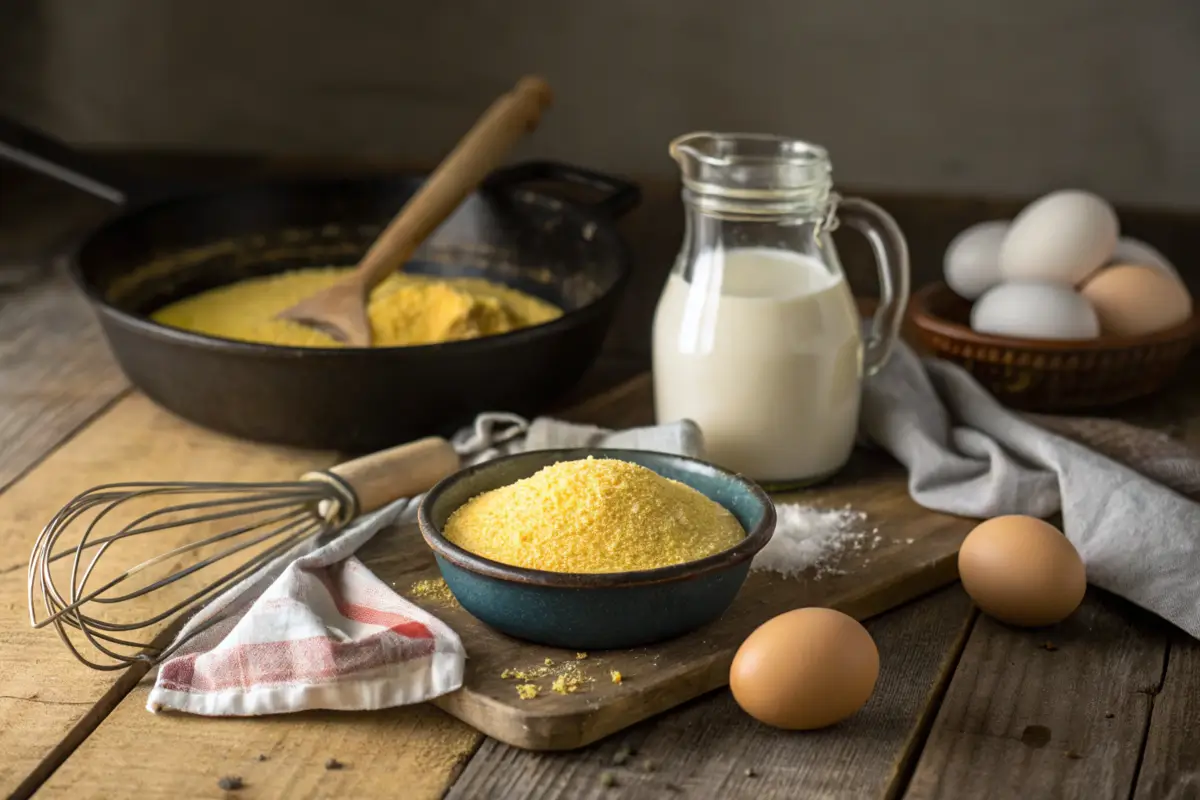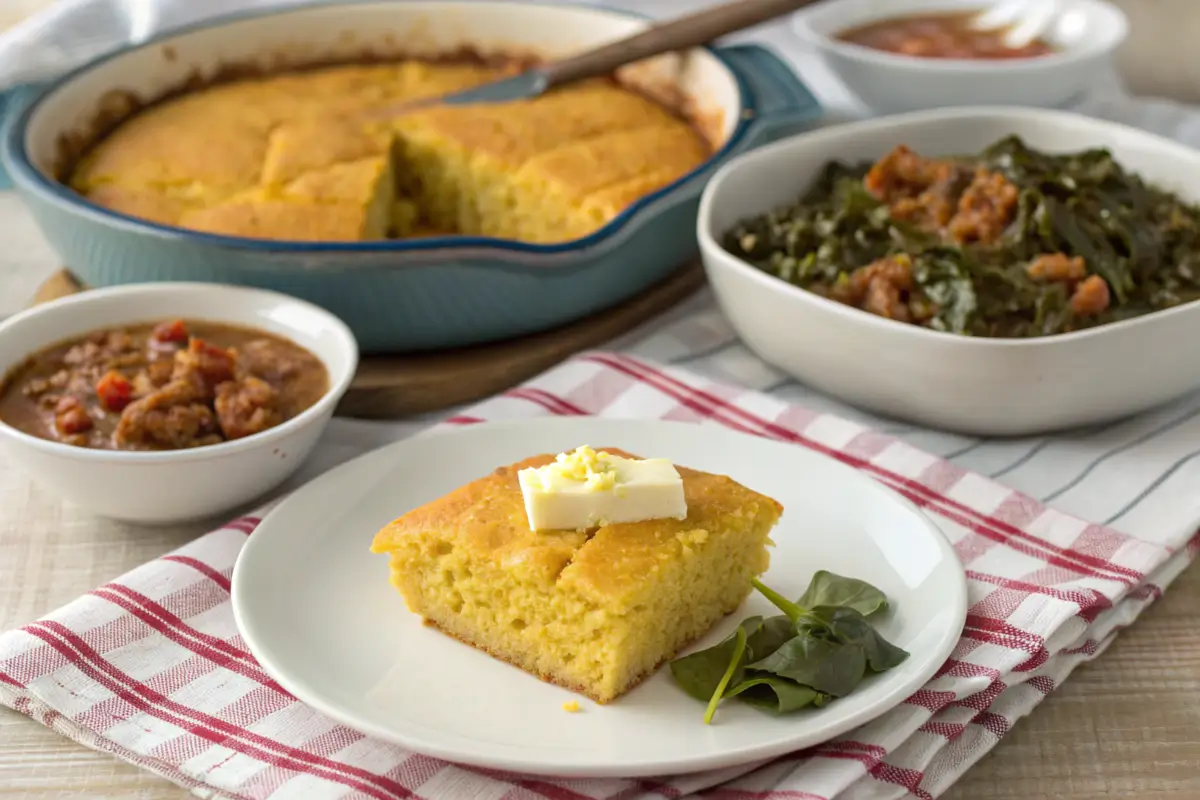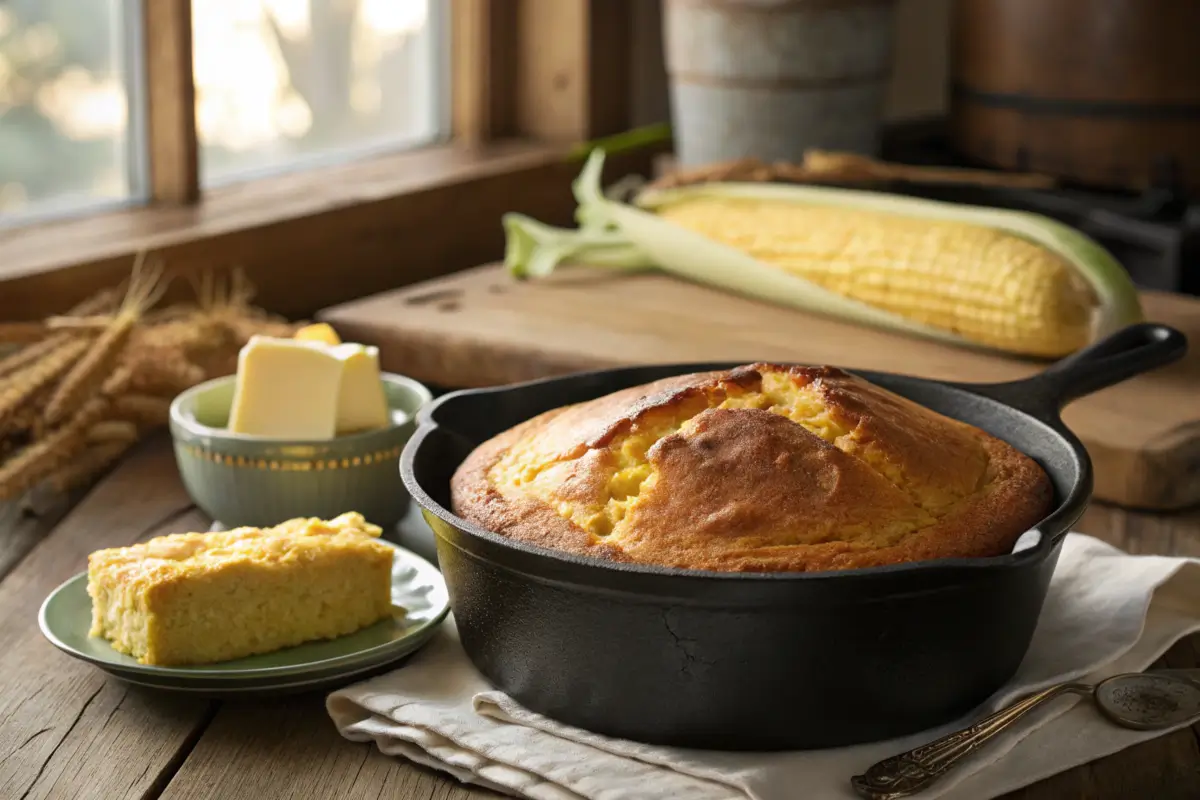Southern cornbread is more than just a side dish; it’s a cornerstone of Southern culinary tradition, brimming with history, flavor, and versatility. Whether served alongside a hearty stew, crumbled into a salad, or savored on its own with a pat of butter, this beloved dish reflects the heart and soul of Southern cooking. In this article, we’ll explore the rich history of this classic dish, uncover what makes it unique, provide you with a foolproof recipe, and highlight variations and serving ideas that will elevate your culinary game. Let’s dive into the delicious world of Southern cornbread recipe perfection.
The History of Southern Cornbread
Origins of Cornbread in Southern Cuisine
Cornbread traces its roots to Native American cooking, where ground corn, or maize, was a dietary staple. The indigenous peoples prepared simple corn cakes that eventually inspired settlers to adapt the recipe using the ingredients available to them. Over time, these early adaptations evolved into the Southern cornbread recipe we know today, reflecting the resourcefulness of cooks in the South.
Cultural Significance and Traditions
For many Southerners, cornbread represents more than just a meal—it’s a family tradition passed down through generations. Served at Sunday dinners, holiday feasts, and community gatherings, cornbread embodies a sense of home and togetherness. Historically, it was an affordable and accessible food, particularly for rural communities, making it a staple of Southern hospitality.
Key Ingredients Through the Years
The defining elements of a true Southern cornbread recipe include yellow cornmeal, buttermilk, and often bacon drippings for flavor. Unlike its sweeter Northern counterpart, Southern cornbread is traditionally savory, with no added sugar. Over the years, variations have emerged, but the focus has always remained on simplicity and highlighting the natural taste of corn.
What Makes Southern Cornbread Unique?
Difference Between Southern and Northern Cornbread
What sets the Southern cornbread recipe apart? For starters, Southern cornbread leans savory, while its Northern counterpart often includes sugar, making it sweeter. Southern cornbread is all about simplicity—cornmeal, buttermilk, and sometimes a touch of fat, like bacon drippings. Meanwhile, Northern cornbread tends to incorporate more flour and sugar, resulting in a softer, cake-like texture. The distinctiveness lies in the crispy crust and robust corn flavor that Southern cornbread champions.
The Role of Buttermilk and Bacon Drippings
Two ingredients truly define Southern cornbread: buttermilk and bacon drippings. Buttermilk adds a tangy undertone, balancing the natural sweetness of the cornmeal while making the batter light and tender. On the other hand, bacon drippings impart a smoky richness that elevates the entire dish. Using a cast-iron skillet heated with these drippings is a hallmark of authentic Southern preparation, ensuring a crust that’s second to none.
Texture and Taste Profiles
Southern cornbread is known for its crumbly, moist interior with a perfectly golden, crunchy exterior. In addition, the use of yellow cornmeal provides a rustic, hearty flavor that’s unmistakable. Therefore, the savory elements of the recipe ensure it pairs beautifully with bold Southern dishes like chili or gumbo, thus making it a staple on Southern tables.
Internal Link Opportunity: While discussing cornbread variations, readers might enjoy exploring the recipe for Swamp Soup, a hearty Southern dish that complements cornbread perfectly.
The Perfect Southern Cornbread Recipe
Ingredients and Their Importance
The magic of a perfect Southern cornbread recipe lies in its ingredients:
- Yellow cornmeal: The star ingredient that defines its flavor and texture.
- Buttermilk: Adds moisture and tanginess.
- Eggs: Help bind the mixture for a tender crumb.
- Bacon drippings or butter: Contribute richness and that classic Southern taste.

Step-by-Step Instructions
- Preheat the skillet: A hot cast-iron skillet is critical for achieving the desired crunchy crust.
- Mix dry ingredients: Combine cornmeal, a pinch of baking soda, and salt for a balanced flavor.
- Incorporate wet ingredients: Whisk buttermilk, eggs, and melted bacon drippings until smooth.
- Pour and bake: Pour the batter into the heated skillet, and bake until the top is golden and the edges pull away slightly.
Tips for the Best Crust
- Always preheat your skillet. A sizzling batter upon contact ensures a crispy crust.
- Avoid overmixing; a lumpy batter prevents toughness.
- Let the baked cornbread rest for a few minutes before slicing to lock in moisture.
Pair this classic recipe with bold flavors or hearty stews for a meal that hits all the right notes.
Internal Link Opportunity: For a sweet complement to your savory cornbread, try this Protein Pudding Recipe Guide, perfect for balancing Southern meals.
Variations of Southern Cornbread
Sweet vs. Savory Cornbread
While traditional Southern cornbread recipes are predominantly savory, modern kitchens have embraced sweet variations. Savory cornbread often relies on ingredients like bacon drippings and buttermilk, creating a rich and tangy flavor profile. On the other hand, sweet cornbread incorporates sugar or honey for a touch of sweetness, making it a delightful standalone snack. Both styles can shine, but their use often depends on the dish they accompany. For instance, savory cornbread pairs beautifully with chili, while sweet cornbread complements a barbecue feast.
Gluten-Free and Vegan Options
For those with dietary restrictions, cornbread can easily be adapted. Gluten-free Southern cornbread recipes swap traditional flour for almond or rice flour, maintaining the crumbly texture without sacrificing flavor. Vegan options replace eggs with flaxseed or chia seeds and use plant-based milk instead of buttermilk. These adjustments ensure that everyone can enjoy a slice of this Southern classic, no matter their diet.
Regional Twists and Additions
Southern cooks are known for their creativity, and cornbread is no exception. Variations abound, from jalapeño-infused cornbread for a spicy kick to cheese-laden versions that add a creamy richness. Some regions incorporate fresh corn kernels or green onions for added texture and flavor. These regional twists reflect the diversity of Southern cuisine and provide endless opportunities to experiment in the kitchen.
Suggestion for Readers: For more hearty and flavorful recipes, check out the Swamp Soup Recipe, which pairs wonderfully with savory cornbread.
Serving Southern Cornbread
Pairing Cornbread with Classic Southern Dishes
Cornbread is the ultimate sidekick to many Southern dishes. A slice of warm, golden Southern cornbread pairs perfectly with hearty meals like gumbo, collard greens, or fried chicken. Its mild, crumbly texture balances bold flavors, making it a versatile addition to any menu. Serve it alongside a bowl of chili or stew to soak up every last drop of goodness.

Creative Ways to Use Leftover Cornbread
Leftover cornbread? Don’t let it go to waste! Crumble it to create a delicious cornbread dressing or use it as a topping for casseroles. Some cooks even transform it into cornbread pudding, blending sweet and savory elements for a unique dessert. For a quick snack, reheat leftover slices and top with butter and a drizzle of honey.
Suggestion for Readers: Looking for a crowd-pleaser dessert to complement your meal? Check out this Dubai Chocolate Bar Recipe for a rich, indulgent treat.
FAQs About Southern Cornbread
What Kind of Cornmeal Works Best?
The cornerstone of any Southern cornbread recipe is the cornmeal, and not all cornmeal is created equal. For authentic flavor and texture, opt for stone-ground yellow cornmeal. It has a coarser grind, which gives the bread its signature crumbly texture and robust corn flavor. Avoid pre-mixed cornbread products, as they often include unnecessary additives. If you want a smoother texture, finely ground cornmeal can be used, but the bold, rustic charm of traditional Southern cornbread might be lost.
Why Use a Cast Iron Skillet?
A cast iron skillet isn’t just a nostalgic nod to Southern tradition—it’s a game-changer for texture. The skillet retains heat evenly, ensuring a perfectly golden crust while keeping the inside tender. Preheating the skillet before adding the batter creates an irresistible sizzle, forming a crunchy edge that’s the hallmark of any great Southern cornbread recipe. Plus, a well-seasoned skillet adds a subtle depth of flavor.
How Do You Achieve the Perfect Golden Crust?
The secret to that mouthwatering golden crust lies in a few simple tricks. First, always preheat your skillet, as the sizzling batter helps set the crust instantly. Second, use bacon drippings or butter for greasing—it enhances flavor and crispness. Lastly, bake at a consistent, moderate temperature (around 425°F) to achieve even browning without overcooking.
Can You Freeze Southern Cornbread?
Absolutely! Southern cornbread freezes wonderfully, making it a great make-ahead option. To freeze, let the bread cool completely, then wrap it tightly in aluminum foil or plastic wrap. Place it in a freezer-safe bag or container, and it will stay fresh for up to three months. To reheat, thaw at room temperature and warm in the oven for a freshly baked taste.
Southern Cornbread in Popular Culture
Mentions in Literature and Media
The humble Southern cornbread recipe has found its way into countless stories, poems, and even films, reflecting its deep connection to Southern life. From Southern gothic novels to nostalgic family-centered movies, cornbread often appears as a symbol of comfort, resilience, and tradition.
Festivals and Competitions Celebrating Cornbread
Cornbread isn’t just food—it’s celebrated as a cultural icon. For example, events like the National Cornbread Festival in Tennessee highlight its enduring popularity. Moreover, competitions showcase innovative recipes, proving that this timeless dish continues to inspire creativity.
As a result, Southern cornbread has cemented its place as a culinary and cultural staple, successfully bridging the gap between past and present, tradition and innovation.
Southern Cornbread: Nutritional Benefits and Considerations
Nutritional Value of Southern Cornbread
The classic southern cornbread recipe not only delights the taste buds but also packs a nutritional punch. Made primarily from cornmeal, it is a good source of complex carbohydrates and fiber, which provide lasting energy. When enriched with eggs and buttermilk, it also offers protein and essential vitamins like B12 and riboflavin. Additionally, stone-ground cornmeal contains vital minerals such as magnesium and iron, making it a wholesome side dish for any meal.
Nutritional Content (Per 100g)
Below is the approximate nutritional breakdown of a traditional southern cornbread recipe:
| Nutrient | Amount (Per 100g) |
|---|---|
| Calories | 189 kcal |
| Carbohydrates | 30 g |
| Protein | 5 g |
| Fat | 5 g |
| Fiber | 2 g |
| Sodium | 300 mg |
| Calcium | 50 mg |
| Iron | 1.4 mg |
Considerations for Special Diets
To make cornbread suitable for various diets, consider these tweaks:
- For gluten-free diets, use almond flour or rice flour.
- For lower fat, replace bacon drippings with olive oil or cooking spray.
- For vegan diets, substitute eggs with flaxseeds and buttermilk with plant-based milk.
These modifications allow everyone to enjoy the timeless southern cornbread recipe without compromising their dietary needs.
The Timeless Appeal of Southern Cornbread
Why Southern Cornbread Endures
Few dishes evoke the sense of nostalgia and community that the southern cornbread recipe does. Its simple ingredients and straightforward preparation make it accessible to cooks of all skill levels. Over generations, it has remained a constant at family dinners, holiday feasts, and even casual gatherings, cementing its status as a cultural icon. The versatility of cornbread ensures it adapts to modern tastes while staying true to its roots.
Southern Cornbread in Modern Kitchens
Even in today’s fast-paced world, cornbread has maintained its appeal. Many home cooks and chefs have reimagined it with innovative twists, from adding unexpected flavors like jalapeños to transforming it into desserts. Its enduring popularity lies in its ability to be both a nostalgic comfort food and a canvas for creativity.
In essence, southern cornbread is more than just food—it’s a testament to the ingenuity and warmth of Southern cooking. Its rich history and versatility ensure that it will continue to grace tables for generations to come.
Conclusion: A Celebration of Southern Cornbread
The southern cornbread recipe is more than just food—it’s a symbol of Southern comfort, culture, and history. With a few basic ingredients, it’s easy to make, and its flexibility lets cooks create many different versions to fit today’s tastes and needs. From its Native American roots to its spot on family tables today, cornbread has stayed popular, changing over time but holding onto its original charm.
Whether you like it savory or sweet, as a side dish or turned into something new, cornbread brings people together. It goes perfectly with stews, chili, and other Southern favorites, adding a warm and satisfying touch to any meal. Even leftovers can be used to make dressings, casseroles, or desserts, so nothing goes to waste.
As food trends change quickly, Southern cornbread remains loved for its ties to tradition and its ability to grow with the times. It reminds us of the simple joys of home cooking and how food brings us closer to our history and to each other. So, grab your ingredients, make a batch, and enjoy the warm, timeless flavor of this Southern classic.

